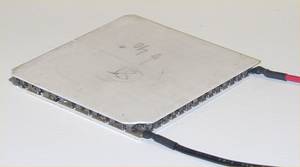In a giant leap for technology, scientists have doubled the electricity-producing efficiency of the thermoelectric material that powered Neil Armstrong's  explorations on the lunar surface.
explorations on the lunar surface.
NASA used a substance then, 43 years ago, called lead telluride; when it's heated, it produces a current. The same principle is widely used in deep space probes and even in systems used to monitor locations that are hard to access on Earth.
But the present generation of thermoelectric materials, like lead telluride and its relative bismuth telluride, suffer from extremely low efficiencies: 5% is considered a good performance, meaning that most of the heat energy they take in is wasted.
But now a team at Northwestern Univesity, lead by Mercouri Kanatzidis, have found a way to significantly improve the performance of these materials.
To work well as a thermoelectric, a material needs to be a good conductor of electricity but conduct heat very poorly, because it's the difference in temperature across the material - between the "hot" side and the "cold" side - that drives the flow of current.
But this is hard to achieve, because most good electrical conductors are also excellent conductors of heat! What the Northwestern team realised is that by paying attention to the atomic, nano and micro structure, it's possible to craft a material that phonons - the atomic vibrations that convey heat through a substance - find very difficult to pass through.
They have used lead telluride containing sodium and strontium nanodot deposits; this alloy they grind and then compact into a highly regimented structure.
The result is a crystal architecture with features on scales similar in size to the phonon waves that convey heat through the material. When the phonons hit these structural details they bounce off, like waves rebounding from a sea wall. But electrons, carrying current, can pass through unimpeded.
In tests, published this week in Nature, the new material performed 100% better than the original lead telluride employed by Neil Armstrong, and at least 30% better than the existing technology.
Moreover, the material is relatively simple to make and, as Kanatzidis points out, there are many industries like power plants and metalworks quite literally "throwing away two thirds of the energy they use", a significant proportion of which could realistically be "recycled" using technology like this.










Comments
Add a comment